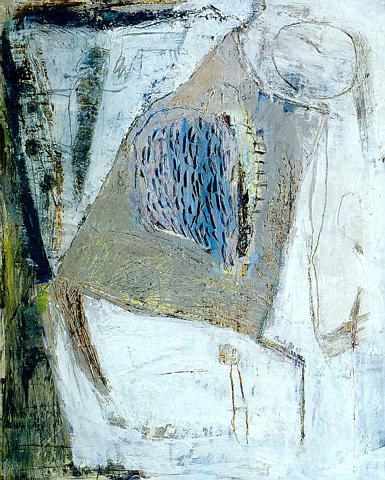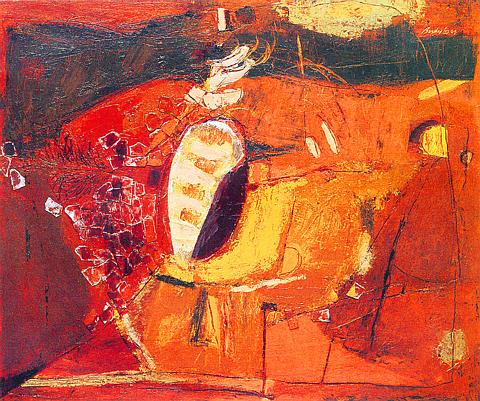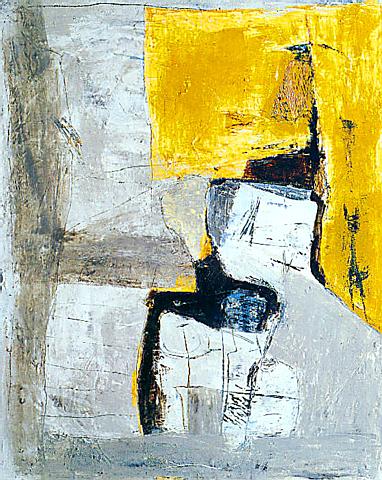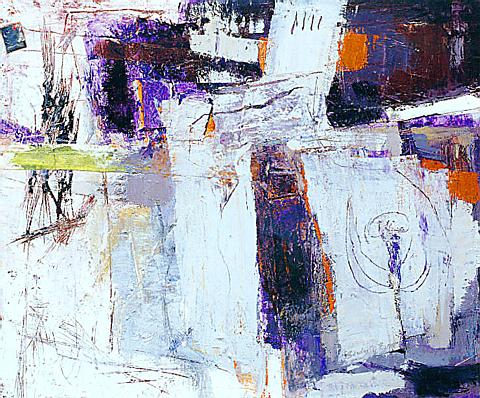Birdy Cheng reckons she is a mostly well-adjusted individual today thanks to the therapeutic value of artistic expression. For her, painting is a way to vent negative moods that otherwise would eat away at her from the inside.
Cheng transfers her deepest, darkest emotions onto canvas in an uncompromising style. This is especially apparent in the work from her 1994 exhibition "Birdy's Diary -- Her Very Self and Illusion." The show featured a series of "Hands of Destruction" paintings: one portrait after another of clenched fists.
As Cheng explains, the inspiration behind most of her art is her severe -- and enduring -- bouts of depression. "I was at a really low point in my life, feeling very despondent, a little violent," she says. "The feeling one gets from those paintings is that the hand is out to wreck and destroy." The years to follow would see little improvement in Cheng's serotonin levels. "Birdy's Transition," her 1998 solo exhibition, seemed to herald a new phase in her artistic development. But according to Cheng, the only significant "transition" made was in the colors she used -- lighter, brighter, less murky.

Birdy Chen
"Actually, you could say that the subjects of those later shows were just extensions of my low mood from 1994," says Cheng, grinning sheepishly.
Jasmine Pan, who manages Pan Pan Art Space, the gallery-cum-cafe where some of Cheng's latest paintings are now on exhibit, offers a different view of Cheng's development as an artist. "When I first saw [Cheng's work] in 1990, I realized she couldn't express her emotions except through art, pouring all of her anger into it. The works were incomprehensible to most people, dark and muddled forms and colors. But now her art is a lot more open. It shows a desire to have others understand what they're looking at, to communicate with the outside world," says Pan.
Cheng's paintings are agitated montages of color and texture composed of geometric shapes and crude lines. Naturally, the subjects of her paintings are sometimes difficult to grasp: physical interpretations of jazz music, anger, and "things that don't exist in this world."

Birdy Chen
She says most people who buy her work are in their 30s; those over 50 "have difficulty accepting [my style] because they can't understand what it's all about."
Born in Keelung, Cheng, 35, studied at the National Academy of the Arts. She didn't really explore abstract painting until her last year there, when she was given more freedom. But there was no turning back after that, she said.
"There are some things I just can't be bothered to explain," she says. "With abstract art, nothing has to be stated too clearly." Cheng, who is known for signing her work "Birdy 3/4G," takes her English name from the 1984 Alan Parker film Birdy in which the title character ends up thinking he's turned into one of his feathered friends.

Birdy Chen
Cheng admits that as a college student she was "not autistic per se, but I didn't know how to express myself and disliked speaking with other people. I basically lived in my own world and still prefer to do so these days." So when a friend suggested Cheng adopt the English name "Birdy," she naturally agreed.
Her paintings are self-dialogues, portraits of her emotional landscape incarnate. Extreme states of mind often compel people to find means to releasing their aggression. Cheng takes hers to the canvas. One of her painting methods is scraping the canvas with a knife, an act she considers a productive form of psychological release.
"Scraping is a very intense physical process. It's as if it leaves a scar. But that feeling might not satisfy you, because when you're really suffering it's like there's this stinging feeling inside," she says.

Birdy Chen
In order to satisfy that "stinging feeling," Cheng experimented with materials and three-dimensional textures. She began gluing pieces of acrylic to the paintings to give them a different feel. In Transition Number 28, a figure resembling a man has a number of shard-like objects protruding from his bloated belly. The end result resembles something of a porcupine on the defensive.
However, even the most banal of situations can provide creative fodder for Cheng. In the oppressive heat of one cruel summer, sweating it out in her air condition-deprived apartment, Cheng says she was "suffering from heatstroke or something," but "couldn't very well go and paint an air conditioner!" The result was Transition Number 31, one of her more accessible pieces. The figure of a black cat is discernible, as is a trickling shower set against a bright yellow background.
Suffice it to say that for Cheng, painting is therapy helping her to attain a kind of equilibrium without having to pay expensive psychiatric bills. Those who plan on double-crossing Cheng in the future, be forewarned: "I might be mad at someone, but I can't exactly take concrete actions against them. However, I can depict them in unfortunate circumstances. I might even use a little humor and show that person having slipped and fallen, with me laughing on the sidelines," she says, nary a hint of sadism in her voice.
Cheng promptly produces a reproduction of one work from her 1994 series: a large, threatening black fist looms against a blood-red background. The outline of a helpless human figure appears to be struggling inside the fist, a fist that could very well be construed as Cheng's own.
But Pan contends that Cheng is far from the anti-social misanthrope, excitedly recounting an incident that happened in early September: a car had hit a dog in the Gongguan area. None of the passers-by were paying it any attention. Then Cheng stepped in to rescue the dog by finding a cardboard box to place it in and taking it to a veterinarian. She later proceeded to post announcements around town, worried that its owner was frantically searching for it.
"Actually, Cheng embraces life," remarks Pan. "Just think of all the people she had to come into contact with in her plight for that dog! Would you consider this type of person an introvert?"
Pan Pan Art Space (

In the March 9 edition of the Taipei Times a piece by Ninon Godefroy ran with the headine “The quiet, gentle rhythm of Taiwan.” It started with the line “Taiwan is a small, humble place. There is no Eiffel Tower, no pyramids — no singular attraction that draws the world’s attention.” I laughed out loud at that. This was out of no disrespect for the author or the piece, which made some interesting analogies and good points about how both Din Tai Fung’s and Taiwan Semiconductor Manufacturing Co’s (TSMC, 台積電) meticulous attention to detail and quality are not quite up to

Chinese Nationalist Party (KMT) Chairman Eric Chu (朱立倫) hatched a bold plan to charge forward and seize the initiative when he held a protest in front of the Taipei City Prosecutors’ Office. Though risky, because illegal, its success would help tackle at least six problems facing both himself and the KMT. What he did not see coming was Taipei Mayor Chiang Wan-an (將萬安) tripping him up out of the gate. In spite of Chu being the most consequential and successful KMT chairman since the early 2010s — arguably saving the party from financial ruin and restoring its electoral viability —

It is one of the more remarkable facts of Taiwan history that it was never occupied or claimed by any of the numerous kingdoms of southern China — Han or otherwise — that lay just across the water from it. None of their brilliant ministers ever discovered that Taiwan was a “core interest” of the state whose annexation was “inevitable.” As Paul Kua notes in an excellent monograph laying out how the Portuguese gave Taiwan the name “Formosa,” the first Europeans to express an interest in occupying Taiwan were the Spanish. Tonio Andrade in his seminal work, How Taiwan Became Chinese,

Toward the outside edge of Taichung City, in Wufeng District (霧峰去), sits a sprawling collection of single-story buildings with tiled roofs belonging to the Wufeng Lin (霧峰林家) family, who rose to prominence through success in military, commercial, and artistic endeavors in the 19th century. Most of these buildings have brick walls and tiled roofs in the traditional reddish-brown color, but in the middle is one incongruous property with bright white walls and a black tiled roof: Yipu Garden (頤圃). Purists may scoff at the Japanese-style exterior and its radical departure from the Fujianese architectural style of the surrounding buildings. However, the property